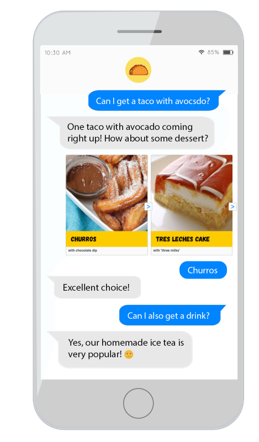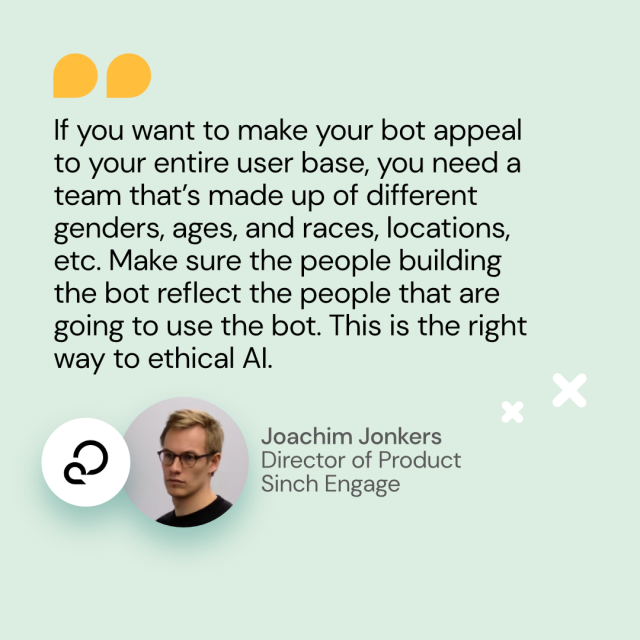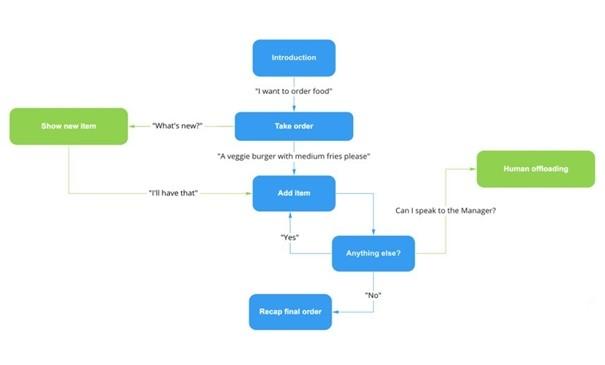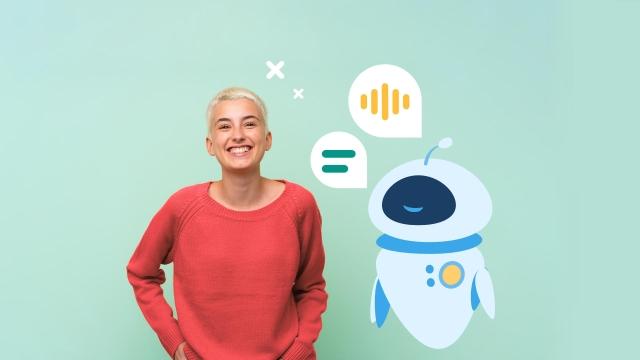In this article:
Conversation design focuses on teaching virtual assistants to interact with humans in a more natural way. Why is this important? How does this work? And, why does this matter for your business? In the following, we’ll cover all the basics!
How many times have you gotten upset because Siri or Alexa gave you an answer that had nothing to do with what you were asking? And how many times have you screamed at your computer because the bot in the web chat never gave you the information you were looking for? Exactly! We've all had frustrating experiences with virtual assistants, but conversation design is here to change that.
What is conversation design?
According to Cathy Pearl, a design manager for Google Assistant , “conversation design creates conversational experiences that teach computers how to interact like humans.”
Just like UX design makes sure that people can interact with a digital interface in a simple and intuitive way, conversation design looks at making the conversational interaction between humans and computers as natural and as fluid as possible. In other words, conversation designers teach virtual assistants how to communicate like humans.
And even though most people think of voice assistants like Siri or Alexa when they hear about conversational design, it's important to note, that the term refers to any type of virtual assistant. This can be a voice bot, but also a chatbot on a web chat or on a messaging app, your intelligent car system, or your smartwatch. And yes, even the infamous ChatGPT!
So, conversation design focuses on any conversational computer system where humans and bots interact with each other.
Why do we need conversation design?
To some people, it might seem unnecessary to worry about conversation design. How complicated can a conversation between humans and bots really be? All you have to do is pre-program some answers to the most common questions, and you're done.
Human: “Can I please get a salad?”
Bot: “Sure, which kind would you like?”
Human: “The chicken salad with Ranch dressing, please.”
Bot: “No problem. It'll be done in ten minutes. How would you like to pay for it?”
Human: “With my credit card.”
Bot: “Perfect, I have received your payment. Thank you, have a great day!”
This sounds easy enough, right? Unfortunately, human conversations are rarely that simple. They can be complex, multi-layered, and ambiguous — and therefore very different from the straightforward (yes / no; if –> then) way computer systems use to operate.
Complexity
Human interaction can be pretty complicated, if you think about it. It doesn’t only involve words, but also intonation, pauses, stress, body language, and eye contact. For example, imagine you walk into a restaurant, and ask about their chicken salad, but then pause, raise your eyebrows, and search for the menu with your eyes because you aren’t sure what dressings they offer. The employee will most likely understand your non-verbal clues and name their dressings. Technically, you haven’t said a word to each other about dressings, but you were still communicating.
The same happens if you write your friend a text message saying: “The party last night was LIT!” They will understand that you had fun (and that it had nothing to do with a fire).
Humans are very good at picking up these cues. Virtual assistants, in turn, typically can only rely on the words that are being said. If humans are not aware of this, but just assume the bot will understand them, it can lead to misunderstandings.
Multiple layers
Human interaction is not only complex, but also multi-layered. If somebody on the street asks you: “Do you know where the closest grocery store is?”, answering only “Yes!” is not appropriate. Why? Because it's implied in the question that if you know where the store is, you're going to explain how to get there. Anything else would be considered rude or strange.
A virtual assistant, on the other hand, will not interact in the same way (unless taught!) — which leads to miscommunication and frustration.
Ambiguity
Even if we use very clear, precise wording, there can still be room for ambiguity. If somebody offers you some chocolate, and you say: “Sugar always gives me such a rush!” Does this mean that you want the chocolate, or not? Depends! If you are trying to pull off another hour at work but are feeling very low on energy: yes. If you're about to go to bed, no.
In most cases, virtual assistants don't have the full context to be able to decipher these types of ambiguities, and humans won't know that they need to explain the entire backstory for the bot to get their meaning.
Teaching bots how to interact with humans
As these examples show, humans and systems don’t communicate in the same way, and this is exactly what can make human-bot-interaction so frustrating. You could, of course, teach humans to use programming languages to interact with bots, but this is neither realistic nor practical nor customer friendly.
That’s why, if you want the human-bot-experience to be positive, you have to teach your systems how to interact with people in a more human-like way. And that’s exactly what conversation design does!
"Conversation design is a combination of technology, psychology, and language that takes into consideration both human and AI limitations and possibilities to create the best user experience possible."
Tess Tettelin | Conversation Design Lead, Sinch Chatlayer
Why does any of this matter for your business?
For a long time, conversation design was a niche topic among designers and IT specialists. However, in the past years, virtual assistants have become more popular, and a part of our everyday experience.
This rise in importance in everyday life is due to technological advances in artificial intelligence in recent years. Thanks to better AI, systems have become smarter and more useful. Even the simplest chatbots can accurately answer up to a third of the most frequently asked questions, saving your customers time and reducing your business costs.
It’s become clear, though, that a smart chatbot is only the first step. If conversations between customers and bots remain awkward, the results will most likely look like this!

However, if the human-bot interaction is smooth, customers will think of your brand more like this!

Conversation design: advantages for your business
Higher customer satisfaction
A good, engaging conversation creates a positive experience between a customer and your brand. Conversation design can add that layer to your virtual assistants and make the customer experience more memorable.
When iFood, Brazil’s largest food delivery company, implemented a conversation design bot into their customer service, their customer satisfaction score reached 91%!
Increased loyalty
At the same time, positive interactions with your brand will keep customers coming back. The better your conversation design, the higher the chances that customers will experience a rich and satisfying conversation. And it’s these engaging interactions that will motivate your customers to come back!
More conversions
Engaged customers are five times more likely to buy only from their chosen brand, and they spend 60 percent more on every transaction. If your conversations are well-designed, customers will respond positively, and take action.

Lower costs
The number of tasks virtual assistants can complete satisfactorily also depends on how good the conversation design is. For businesses this means: the better the conversation design, the more resources you can save.
By using a well-designed chatbot to answer Covid-19 questions, the European Parliament was able to reduce service costs by 70%.
How does conversation design work?
There are several stages to designing a conversation.
1. Setting up a template
A template is like the road map of your conversation design. It should include the starting and end point of the conversation, and the different paths users can take to get there.
2. Creating a flow chart
With a flow chart, you map out in more detail where a conversation might go, and how different points of the conversation might connect back up. What happens, for example, if a user asks a question twice? Should the conversation go back to the original flow, or diverge into a different direction? This can get quite complex but think of it like a system of interconnected highways that can lead people to their final destination.

3. Writing the text
Once you have set up the flow chart, you can start writing the text. Tip: Start with the foundational flows and go from there. Also mark the intersections where users might be confused to set up alternative flows (and texts) from there.
4. Perfecting the first and last impression
The first and last interaction will have the biggest impact on the user. Take some time to really craft that first and last impression.
5. Being prepared for road bumps
No matter how great the conversational design is, there'll be moments where your bot will not be able to answer a question. Plan how the bot should respond in these situations, so the user won’t break off the communication. The most important part of conversation design is to find creative wordings when there is a problem.
🤖 Ready to take your bot experience to the next level? With Sinch Engage you can set up high-quality bots that don't require any programming skills.
Guiding principles for conversation design
There are certain principles humans use to have a fluent conversation. Some of the most significant are the cooperative principle and conversational implicature.
Cooperation
The cooperative principle ensures that the interaction is helpful and relevant. Take a look at this conversation:
“Do you know what time it is?”
“Yes!”
Now check out this one:
“Do you know what time it is?”
“Sure, it’s five PM.”
While technically, the first answer is correct, it’s neither helpful nor relevant to the person that asked the question, whereas the second answer takes into consideration the principle of cooperation, and is both, helpful and relevant.
Implications
As mentioned, in human conversation, there's a lot of subtext or ambiguity. For example, if somebody says, “It’s been a day!”, a bot has to understand that this doesn’t just mean that it's not nighttime, but that the person has had a long and tiring day.
Conversation design has to account for that, for example, by setting up a “library of implications” that the bots can access in order to understand what certain expressions imply.
For example, if the bot understands that the expression “It’s been a day!” implies that somebody is looking for a way to unwind, a possible reply could be: “Have you checked out the new spa down the street?”
These are the type of answers that'll make the conversations between bots and humans not only more fluid, but also more meaningful!
Conversation design and ethics
Conversation designers have to consider ethical principles as well. Are we biased or excluding certain groups from the conversation by the language we are using? Also, how can virtual assistants respect the users’ privacy, and handle their data responsibly?
These questions must be considered from the beginning and require input from diverse teams and specialists from different fields, such as psychology, philosophy, linguistics, legal experts, and more.

Designing your first chatbot
There are a few things you should consider when designing your first chatbot.
Put the customer first
When designing a chatbot, think of aspects that would make the user experience better.
- What are your customers’ pain points?
- What are the most common questions your customers ask?
Establish what your customers need first, and then design a chatbot that can help them.
"You can only design a good chatbot, and have it say the right things, if you know exactly what your chatbot is supposed to do (and say), and who they are talking to.”
Céline Lémonne | Conversation Designer Sinch Chatlayer
Create the conversational flow
Once you established a use case for the chatbot, you can start creating the conversational flow. Always think from the users’ perspective. Once they asked the first question, what would a typical follow-up question be? This will help you create more useful flow charts.

Give your bot a personality
A bot is like a brand ambassador, so it’s important to give it a personality that mirrors your brand.
The Indian Orion Mall, for instance, called their conversation design bot “Genie” because they wanted the bot to represent their customer-first philosophy.

Establish a way to talk to a human agent
There will always be situations where human help is needed. Make sure that, at any point in the flow, users can ask for human help.
After all, bots and humans work as a team, and bots are there to reduce the workload for your team, but also to make sure that complex questions are passed on to be handled with care by your agents.
Optimize
After launching your bot, make sure that you analyze the performance, and adapt and improve it. Are there questions that keep coming up that your bot can’t answer? Do you observe disruptions in the conversation at specific points? These are great observations that can help you improve your bot, and the customer experience!
Work with an experienced team
If you want to create a more engaging human-bot experience, make sure that you work with a professional and experienced conversation design team (hint: we can help you with that 😉)!




